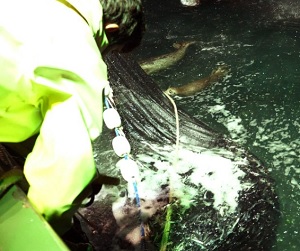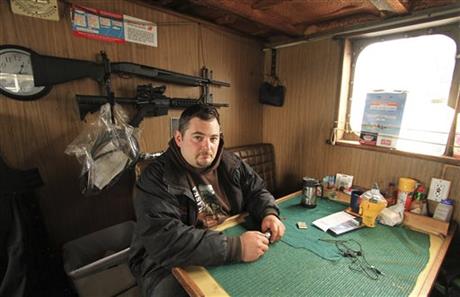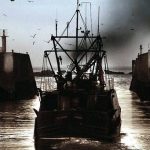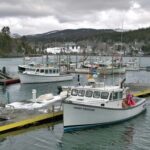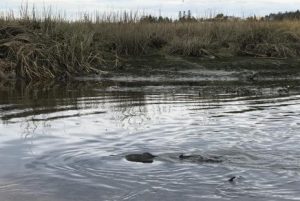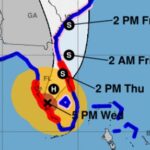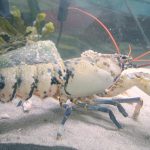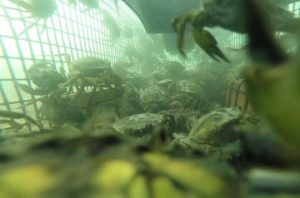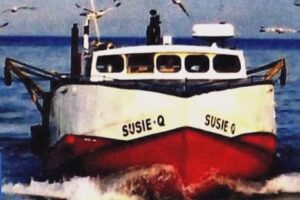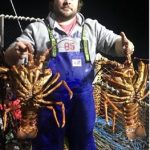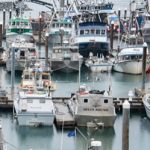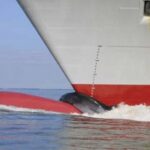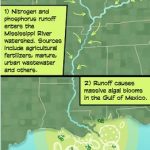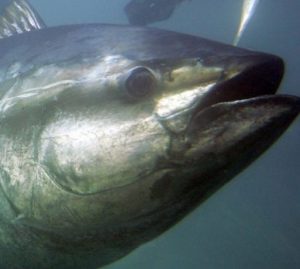Tag Archives: Marine Mammals

New Report Suggests “Whale Psychiatrist” Trump May be Right About Wind Farms and Whales
US Bureau of Ocean Management report says whales, dolphins, birds and bats can all be injured by wind turbine construction, and offshore fishing harmed. Trump has been an advocate for keeping America clean and healthy. He has not advocated for the anti-carbon push based on pseudoscience and the rush into green energy projects put forth by environmentalists. Admittedly. the National Oceanic and Atmospheric Administration (NOAA) has officials saying they have found no evidence linking offshore wind turbines to whale deaths. However, a new report from the U.S. Bureau of Ocean Energy Management (BOEM) has just released a new report that said whales, dolphins, birds and more can be exposed to “unavoidable adverse impacts” by the construction of offshore wind farms. more, >>CLICK TO READ<< 08:50
New Federal Report: Offshore Wind Farm Construction Can Harm Whales, Birds, Fisheries – >>CLICK TO READ<<
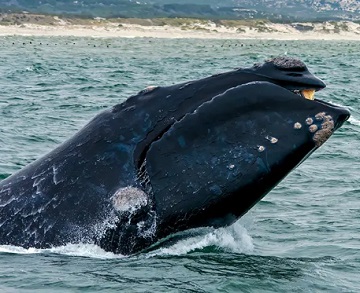
The Whale Killing Study the Feds are Afraid to Do
The Feds have admitted that offshore wind development can cause the death of whales and other marine mammals, but they refuse actually to assess that threat for any wind facilities. So I here outline what such a study should look like. This sort of study is what they are afraid to do because it would give numbers to the deaths that are likely to occur, species by species. First off, here is the Feds’ own description of some of the known deadly threats. In this case, the offshore wind activity is driving the monster piles that support the turbine towers, but there are others. >click to read< 10:02

A strong seal products industry is good for Canada: Senator Manning
Seal fur and leather are transformed into a variety of clothing items, accessories and home furnishings. Seal fats and oils, high in Omega-3 fatty acids, are used in health supplements. Seal meat is sold in various cuts for human and animal consumption. Encouragingly, new and emerging markets for seal products are being tested, including the use of seal bait in fishing. However, vocal anti-sealing campaigns and Europe’s ill-founded 2009 ban on the importation and sale of seal products have hampered the industry’s growth. Less demand for those products drove down their value. And as sealing became less profitable, participation in Canada’s annual seal harvest decreased. In the meantime, the seal population in the Atlantic has been growing and growing. Canada is now trying to grasp what effect more seals in the sea is having on fisheries, fish stocks and the ocean ecosystem at large. >click to read< 11:30

Feds play shell game with wind / whale impacts
NOAA is taking public comments on a massive proposal to harass large numbers of whales and other marine mammals by building a huge offshore wind complex. There is supposed to be an Environmental Impact Statement (EIS) for the proposed harassment, but it is not there with the proposal. We are told it is elsewhere but after searching we find that it simply does not exist. Like a shell game where the pea has been palmed, there is nothing to be found. First the bureaucratic background. The wind project is Dominion’s 2,600 MW offshore Virginia facility, which if built would be the world’s biggest. NOAA’s National Marine Fisheries Service (NMFS) is proposing to issue a five year harassment authorization for the construction of this monster. >click to read< 07:36
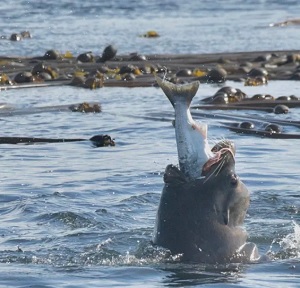
Are sea lions and seals eating too much of B.C.’s salmon? The answer may lead to a cull
An increasing number of the protected seals and sea lions (larger than seals, sea lions can walk) may be upsetting the balance of the British Columbia marine ecosystem. Now some First Nations are proposing a cull. “Environmentalists trying to stop traditional seal and sea lion hunts … are trying to starve out the Indians,” says Tom Sewid of the Kwakwak’wakw First Nation on northeastern Vancouver Island. “I won’t put up with it.” And as seals and sea lions have prospered, salmon have struggled. “The demise of the salmon runs in British Columbia is equivalent if not greater than the extinction of the great buffalo herds across the Great Plains” in the 1800s, says Sewid. > click to read < 09:01
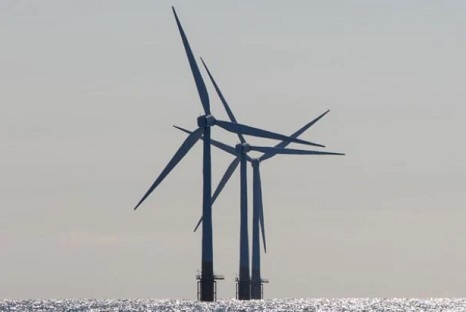
Martha’s Vineyard lobstermen oppose NOAA “incidental take” decision
Lobstermen Wayne Iacono and Wes Brighton expressed frustration at the “double-standard” that NOAA seems to be playing by giving Vineyard Wind an incidental “take” count. The Marine Mammals Protection Act defines take as “to harass, hunt, capture, or kill, or attempt to harass, hunt, capture, or kill any marine mammal.” Vineyard Wind is allowed some incidental take, which is “unintentional, but not unexpected, taking,” according to NOAA. One species, in particular, the lobstermen are worried about is the endangered North Atlantic Right Whale. >click to read< 15:41
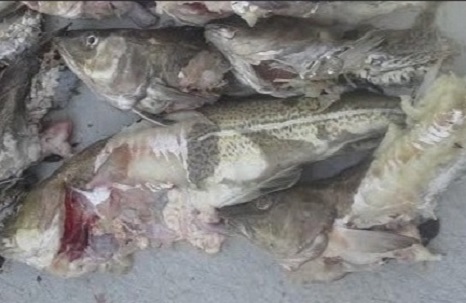
“DFO operates in denial of Reality”- Scientist says seal predation not having a significant impact on spawning cod stocks
Instead, Karen Dwyer, weighing in on the contentious debate over the health of cod stocks, said Thursday that environmental factors and a limited supply of the cod’s primary food source — capelin — are more to blame.,, Trinity Bay fisherman Keith Smith said DFO continues to downplay the impact of seal predation on cod. “It’s like DFO operate in denial of reality,” Smith said. “Fishing mortality is at an all-time low while natural mortality, likely led by the growing seal population that consumes vast amounts of both capelin and cod, remains high,”,,, >click to read< 11:04
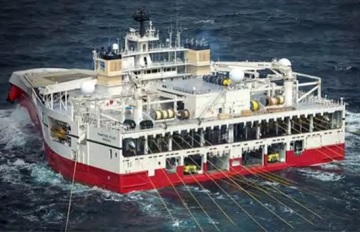
Scientists cast doubt on seismic testing environmental mitigations in N.L.’s offshore
Jack Lawson spent part of this past summer listening for whales around Newfoundland, using recorders moored underwater to track their movements and hear what man-made sounds they may encounter. “All you can hear 24 hours a day, for months on end, every 10 seconds is the boom of a seismic array going off at various distances from our acoustic receivers, and this has made it very hard for us to detect some species, The guns make it hard for Lawson and his team’s recorders, with the technology confusing the pulsing calls of right whales with seismic activity in the distance, DFO scientists thought they’d recorded tens of thousands of instances of right whale calls in the Flemish Pass in 2019, Lawson said. “[But] when we actually went through and manually reviewed these, none of them turned out to be real.” >click to read< 10:41
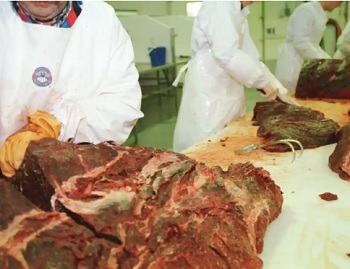
Demand for whale meat in Norway rising after years of decline
Norway remains one of only three countries to publicly allow commercial whaling, along with Japan and Iceland. Much of the catch is sent to Japan, where demand is high, but for the first time in years businesses have reported increased interest in eating whale meat domestically. Four hundred and eighty-four minke whales have been killed so far this year, which is fewer than half the annual quota of 1,278. Last year’s total of 429 whales caught was the lowest in decades. The fleet has also been in decline, with only 12 vessels participating in this year’s hunt, down from 34 in 2004. Odd Emil Ingebrigtsen, Norway’s fishing minister, said: “It is very positive that we are witnessing an increase in both catches and demand for products this year. >click to read< 14:04
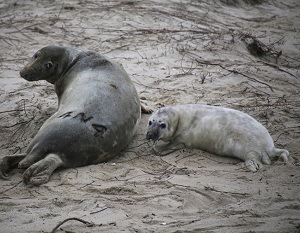
Are they overpopulated, and should they be managed? Study Documents Growing Population of Gray Seals
Gray seal pupping season comes to an end off the coast of Massachusetts and Maine, as a group of federal, state and local scientists are finishing a study on the health of the animals. One of the research teams did its work on Muskeget island, a 240-acre spit of sand west of Nantucket that hosts the largest gray seal pupping colony in the U.S. Referred to by some as the diesel engine of the booming seal population in the region, which in the 1970s faced near extinction (BS), Muskeget has become dominated by breeding seals during pupping season.,, Ms. Murray said a 2016 study found 27,000 seals in Cape and Islands waters,, >click to read< 09:36
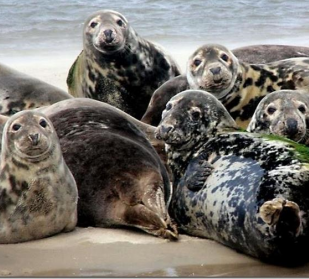
LETTER: Standing up for our fishery
A famous Newfoundland and Labrador politician was once asked about the impact of seals on the fish stocks off our coast. He replied using the wit many good Newfoundland orators are known for and said something to the effect of well, they don’t eat Kentucky Fried Chicken. He was absolutely right then and the same holds true today as we see thousands of tons of fish consumed daily off our shores by these cute-looking mammals with voracious appetites for cod, crab and other lucrative species; the same fish our harvesters and processors depend on,,, by Paul Lane >click to read< 07:21

The costs of depredation: Underwater Cameras Tackle Tough Questions for Fishery
Scientists at the Woods Hole Oceanographic Institution (WHOI) and the Center for Coastal Studies (CCS) are working with local fishermen on Cape Cod to understand exactly what happens when seals and other marine mammals invade a fishing net to forage.,,, The costs of depredation—when marine animals prey on fish caught in nets—can be high on both fronts. On the economic side, it can reduce the amount of sell-able fish and lead to torn fishing nets. “A five-inch opening in the net can quickly become a 15-inch hole when a seal gets caught and tries to free itself,” said Doug Feeney, a commercial fisherman based in Chatham, Massachusetts. >click to read< 12:30
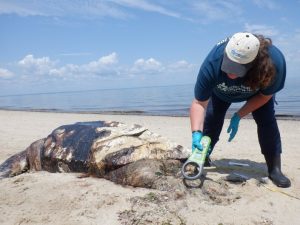
73% Of Sea Turtles Killed In 2019 Died From Vessel Strikes: AMCS
A startling number of sea turtle deaths in local waters have been attributed to vessel strikes, a new report says. The Atlantic Marine Conservation Society said, so far in 2019, the organization has responded to 168 marine mammals, including whales, dolphins, porpoises, seals, and sea turtles that have stranded on New York shores. Sea turtles specifically, which share area waters in the warmer months, have been significantly impacted by humans, with 73% having been struck and killed by marine vessels from the East End of Long Island into New York City,,, >click to read< 13:00
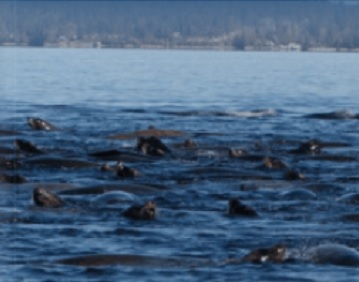
Sea Lions, Other Marine Mammals Discovering South Sound Anchovy Boom
A large suite of marine mammals has discovered Deep South Sound’s new bounty of anchovies, schools of which are now so numerous they’re routinely observed during regular aerial surveys. For three months this past winter, WDFW biologist Steve Jeffries observed hundreds of California sea lions, as well as harbor seals, harbor porpoises and long-beaked common dolphins feeding on a massive pod of the skinny, silvery baitfish in Case Inlet north of Olympia. Anchovy populations have boomed in these waters since 2015 and the Blob’s warm waters. What’s more, the pinnipeds and cetaceans appeared to be teaming up on them. >click to read<20:01
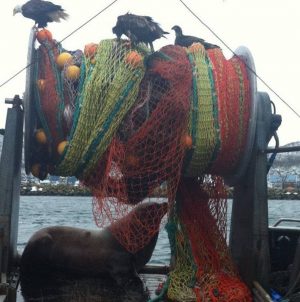
Another Sand Point fisherman is chomped on by a sea lion
A sea lion lunged from the Sand Point harbor and bit a fisherman’s leg in the Aleutian Islands fishing town that’s now experienced three injurious run-ins with the massive marine mammals in two years. “The sea lion came out of the water on the back of the fishing boat Celtic and bit a male fisherman on the right thigh,” said Sand Point police officer David Anderson. Photos, >click to read<22:02
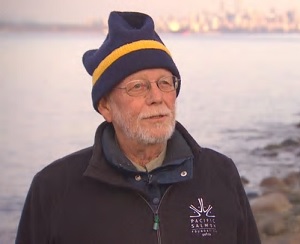
‘Get the balance back’: Amid seal and sea lion boom, group calls for hunt on B.C. coast
For the first time in decades, a small-scale seal hunt is taking place on Canada’s West Coast — all in the hopes that it leads to the establishment of a commercial industry to help control booming seal and sea lion populations and protect the region’s fish stocks.,,, The hunting of seals and sea lions — which are collectively known as pinnipeds — has been banned on the West Coast for more than 40 years. It’s one reason their numbers have exploded along the entire Pacific coastline of North America.,,, Fisheries scientist Carl Walters, a professor emeritus with UBC, believes culling the regions sea lions and seals could dramatically boost salmon stocks. He points to numerous studies showing how pinniped populations have been increasing, while salmon numbers have been plummeting. >click to read<17:14
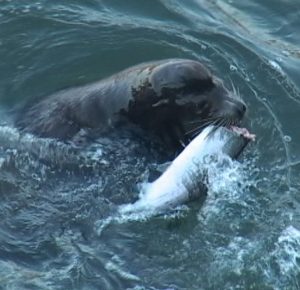
Solution to deal with B.C.’s sea lion surplus? Harvest them, group suggests
Sea lion populations have been on the rise for years and wreaking havoc on commercial fishermen’s catches and equipment, according to the Pacific Balance Pinniped Society. Adult male California sea lions can grow to as big as 800 pounds and consume massive quantities of fish as they grow. “Out in the waters and in our rivers, the pinniped populations have just exploded and we know they’re targeting mainly salmon, steelhead, trout and other fin fish species,” said Thomas Sewid. He believes seals and sea lions are over-abundant in B.C. waters and is spearheading a solution to deal with them. “Not just the natives want to start harvesting pinnipeds,” said Sewid. “This is an industry that can explode throughout coastal British Columbia.” >click to read<21:08

A Provincetown fisherman’s appraisal of the great white dilemma
It finally happened: two worlds collided. The great white shark world collided with the human world and the result was a man being bitten at Longnook Beach. We’re thankful he was saved and is recovering. But how did we get here? It started in 1972 with the Marine Mammal Protection Act, which prohibits hunting or harassing marine mammals, including seals. Before this law fishing communities hunted seals for their pelts and to manage the herd, because they eat enough fish to threaten the livelihoods of commercial fishermen. There were actually payments made by fishing towns to anyone who brought in a seal nose. The threat to commercial fishing was seen as very real. With the 1972 law, the hunt was stopped and seals began reproducing at a far greater rate than was expected. >click to read<11:55
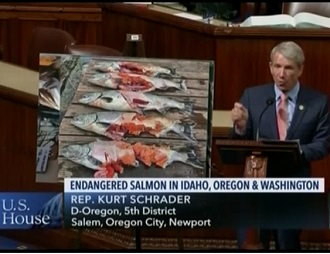
Congress must choose threatened salmon over sea lions
State, federal and local governments have spent too much time and money restoring fish runs in the Columbia River Basin to let those efforts go to waste. The U.S. House recognized this reality last month by passing legislation to make it easier to kill sea lions that feast on threatened salmon and steelhead in the Columbia River and its tributaries. Now, the Senate must step up and push the bill through to the finish line. Northwest senators must be unified in their support for this common-sense measure, which aims to safeguard the billions of dollars invested in preserving fish that are listed under the Endangered Species Act.>click to read<
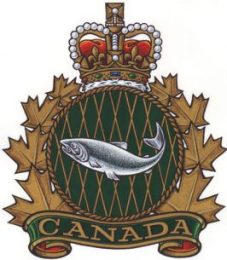
New regulations to protect marine mammals in effect for all coasts in Canada
New regulations to protect whales, dolphins and porpoises are in effect for all coasts in Canada as the Department of Fisheries and Oceans works to ensure more officers and patrol vessels are available to enforce the rules.,,, The regulations include the requirement to report to the Fisheries Department any incident of a vessel accidentally striking a mammal or when it becomes entangled in fishing gear, Cottrell said. Under the Fisheries Act, anyone who disturbs marine mammals could be fined up to $100,000 or a maximum of $500,000 for a criminal offence, Cottrell said. >click to read<14:38

Iceland company to resume commercial hunting of fin whales
A whaling company in Iceland said Tuesday it is preparing its fleet to bring commercial hunting of fin whales back to the Nordic island nation after a two-year freeze. Whaling company Hvalur hf (Whale Inc.) said it is readying two vessels for the 100-day summer whaling season. Fin whale hunting stopped in Iceland after the 2015 hunt, when Japanese authorities refused to import Iceland’s catch because of unmet health code requirements. Fin whales are the world’s second-largest whales after blue whales, and Iceland is the only country where the marine mammals can be hunted commercially. >click to read<15:24
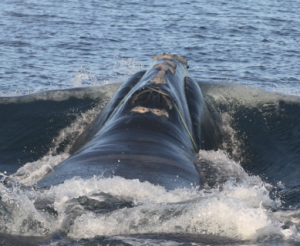
Canada to introduce mandatory reporting of whale interactions this year
“Save the Whales” will take on new importance for Canadian fishermen in 2018 as the Department of Fisheries and Oceans introduces mandatory reporting for interactions Canada’s commercial fishing fleets have with marine mammals. The deaths of a dozen critically endangered right whales in the Gulf of St. Lawrence last year is the driving force behind the effort, which has already resulted in changes in the Gulf of St. Lawrence snow crab fishery, whose gear has been implicated in some of the deaths. >click to read<08:18
Sea lions hinder salmon conservation
 California and Steller sea lions took a bigger bite out of last year’s salmon run than in any previous year, according to a new federal report. 2015 saw a bigger run, with more than 239,000 chinook and steelhead migrating past Bonneville Dam. That year, the total number of salmon that sea lions ate was he largest ever recorded. The Army Corps of Engineers recorded more than 260 sea lions eating more than 10,000 fish from January to June 2015. The 2016 salmon run was far smaller, but the sea lions’ appetite for salmon didn’t shrink much. They still ate more than 9,500 fish, nearly 6 percent of the run. That’s the largest share of the run eaten by the large marine mammals since Army Corps scientists started watching 15 years ago. Read the rest here 12:43
California and Steller sea lions took a bigger bite out of last year’s salmon run than in any previous year, according to a new federal report. 2015 saw a bigger run, with more than 239,000 chinook and steelhead migrating past Bonneville Dam. That year, the total number of salmon that sea lions ate was he largest ever recorded. The Army Corps of Engineers recorded more than 260 sea lions eating more than 10,000 fish from January to June 2015. The 2016 salmon run was far smaller, but the sea lions’ appetite for salmon didn’t shrink much. They still ate more than 9,500 fish, nearly 6 percent of the run. That’s the largest share of the run eaten by the large marine mammals since Army Corps scientists started watching 15 years ago. Read the rest here 12:43
Navy to Expand Sonar, Other Training off Northwest Coast
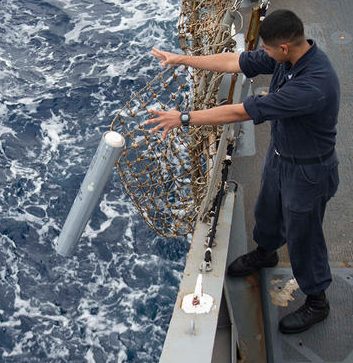 The U.S. Navy has finalized a plan to expand sonar testing and other warfare training off the coasts of Washington, Oregon and northern California. The Navy decided to implement its preferred plan after a lengthy review that included a determination from the National Marine Fisheries Service that the exercises would not have major impacts on endangered orcas and other marine mammals. It announced its decision on Nov. 4. The fisheries service last year renewed the Navy’s five-year permit, through 2020, to conduct the activities in areas from the inland waters of Puget Sound in Washington state to the northern coast of California. The plan includes expanding the use of “sonobuoys,” devices that send out underwater sonar signals used by air crews training to detect submarines. Read the rest here 16:54
The U.S. Navy has finalized a plan to expand sonar testing and other warfare training off the coasts of Washington, Oregon and northern California. The Navy decided to implement its preferred plan after a lengthy review that included a determination from the National Marine Fisheries Service that the exercises would not have major impacts on endangered orcas and other marine mammals. It announced its decision on Nov. 4. The fisheries service last year renewed the Navy’s five-year permit, through 2020, to conduct the activities in areas from the inland waters of Puget Sound in Washington state to the northern coast of California. The plan includes expanding the use of “sonobuoys,” devices that send out underwater sonar signals used by air crews training to detect submarines. Read the rest here 16:54
What happened to all the Chinook Salmon? New research points to potential predators
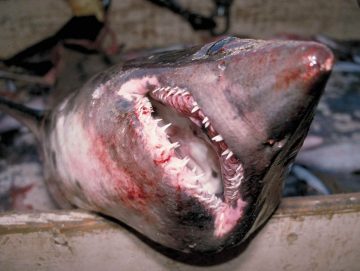 In the 1960s, king salmon were abundant in Alaska, and it stayed that way through the 90s. After the new millennium, though, Chinook numbers fell — and they’ve remained low since. “People have scratched their heads and said, ‘Where are all the kings? What happened to all the kings?’” said Andy Seitz, an associate professor at the University of Alaska Fairbanks School of Fisheries and Ocean Sciences. At a lecture in Unalaska this week, Seitz explained how his research team has studied adult Chinook in the Bering Sea for the last three years. The project relied on pop-up satellite tags, which attach to salmon and measure the water temperature, depth, and ambient light of their environment. Seitz and his team think warm-blooded salmon sharks ate the kings and their tags, and the odd data was recorded when fish were trapped in the sharks’ guts. He also said they found five instances where marine mammals and other unidentified predators could have killed Chinook. Read the story here 18:41
In the 1960s, king salmon were abundant in Alaska, and it stayed that way through the 90s. After the new millennium, though, Chinook numbers fell — and they’ve remained low since. “People have scratched their heads and said, ‘Where are all the kings? What happened to all the kings?’” said Andy Seitz, an associate professor at the University of Alaska Fairbanks School of Fisheries and Ocean Sciences. At a lecture in Unalaska this week, Seitz explained how his research team has studied adult Chinook in the Bering Sea for the last three years. The project relied on pop-up satellite tags, which attach to salmon and measure the water temperature, depth, and ambient light of their environment. Seitz and his team think warm-blooded salmon sharks ate the kings and their tags, and the odd data was recorded when fish were trapped in the sharks’ guts. He also said they found five instances where marine mammals and other unidentified predators could have killed Chinook. Read the story here 18:41
New Zealand: Jamie Briggs calls for seal cull in Coorong and Lower Lakes
Politicians and council mayors have called for the state government to act on the exploding 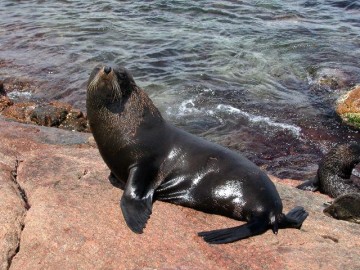 population New Zealand fur seal in the Coorong and Lower Lakes. Federal Member for Mayo Jamie Briggs wrote to minister Jay Weatherill asking for the state government to consider population management of seals because of the impact on commercial fishing operators. “While I appreciate it is a difficult political decision to engage in population management, I believe the time has arrived where this must be undertaken,” Mr Briggs said. He said the sustainability of businesses and the local environment were at risk. Read the rest here 17:05
population New Zealand fur seal in the Coorong and Lower Lakes. Federal Member for Mayo Jamie Briggs wrote to minister Jay Weatherill asking for the state government to consider population management of seals because of the impact on commercial fishing operators. “While I appreciate it is a difficult political decision to engage in population management, I believe the time has arrived where this must be undertaken,” Mr Briggs said. He said the sustainability of businesses and the local environment were at risk. Read the rest here 17:05
Seal cull not yet warranted despite large salmon diet say researchers
 Harbour seals off B.C.’s South Coast may consume up to 60 per cent of the Strait of Georgia’s young chinook and coho salmon every year, according to UBC research. Growing concerns about B.C.’s salmon numbers has focused on orca populations and rising water temperatures in the past, but this study suggests the dramatic increase in the harbour seal population in recent decades may play a role as well. Still, the connection between low salmon stocks and a large harbour seal population is not clear enough to warrant a seal cull, scientists warn. Read the foolishness here 10:49
Harbour seals off B.C.’s South Coast may consume up to 60 per cent of the Strait of Georgia’s young chinook and coho salmon every year, according to UBC research. Growing concerns about B.C.’s salmon numbers has focused on orca populations and rising water temperatures in the past, but this study suggests the dramatic increase in the harbour seal population in recent decades may play a role as well. Still, the connection between low salmon stocks and a large harbour seal population is not clear enough to warrant a seal cull, scientists warn. Read the foolishness here 10:49
Dive fishermen and sea otters face complex competition – “They’re totally eating us out of house and home.”
 What many Americans consider to be a cute, back-floating mammal is a pest, even a thief, to some Southeast Alaskan fishermen. Humans and sea otters enjoy consuming the same bottom-dwelling seafood: Dungeness crabs, clams, sea cucumbers and urchins. Competition between dive fishermen and sea otters for those resources has intensified as the otter population grows. Wadley has been a for 27 years. She dove for abalone until the dive fishery closed in 1996. “We had an abalone fishery here until the otters ate us out of it,” Read the article here 08:05
What many Americans consider to be a cute, back-floating mammal is a pest, even a thief, to some Southeast Alaskan fishermen. Humans and sea otters enjoy consuming the same bottom-dwelling seafood: Dungeness crabs, clams, sea cucumbers and urchins. Competition between dive fishermen and sea otters for those resources has intensified as the otter population grows. Wadley has been a for 27 years. She dove for abalone until the dive fishery closed in 1996. “We had an abalone fishery here until the otters ate us out of it,” Read the article here 08:05






